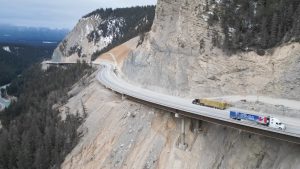The Snow Lion, a Chinese-made loader-mounted ice breaker, is heading into a second season of trials with the Ministry of Transportation (MTO) on northern Ontario roads.
The initial tests last winter were generally positive as the machine did a good job of breaking up ice-pack and getting down to a half-inch of the road surface without creating divots, says Ken Mossop, the MTO’s regional maintenance engineer for northwestern Ontario. "We have a lot of gravel and oiled roads up here and rutting and ice-pack are an issue."
However, they’ve also found a drawback in how the Snow Lion needs to be mounted.
"It’s a bit awkward in that it has to be mounted onto a loader which really isn’t designed for it and the transmission isn’t set up for it," he says. "Still, we’re going to deploy it in some other scenarios this coming winter to get a better idea."
The manufacturer gave the MTO a test model but they cost about $250,000 each, which Mossop says is a lot for a machine that is considered the "weapon of last resort" in winter road management.
"This is something we’d deploy only after we’d gone out with the trucks, scrapers and salt," he says.
"And once you mount it you can’t use that vehicle for anything else which ties up a piece of equipment for a single use."
Also on deck for testing this winter in the northern region will be the Finnish-made Raiko, which is a much smaller and lighter attachment, priced at $40,000.
Like the Snow Lion deployment, testing is to improve friction and retention of winter sand on the road surface, though testing for surface friction before and after has proved inconclusive.
Mossop says the average speed of the Snow Lion loader is 25 km/h based on tests in Dryden with local maintenance contractor Emcon Services.
So far they’ve tested it on Highway 605, west of Dryden, and on Highway 601, north of Dryden.
The highways were chosen because they run the gamut of asphalt, chip seal surfaces and pavement markings.
The project will measure the impact to road surfaces and provide some hands on experience for operators which will be weighed against operational costs.
Neither the Snow Lion or the Raiko have their own motor drive, instead the ice breaking components — which are of different designs in each — are activated by the inertia of moving across the road surface.
In the Snow Lion’s case, a cylinder comprised of rows of steel disks rotate while actuators force downward on the rotating cylinder to break up accumulated ice and snowpack.
An auger system moves the loose material to the roadside.
The Raiko is smaller and has a series of rotating cylinders with 2.5 inch tines that punch into the hard pack, breaking it up.
The system is distributed in North America by Team Eagle of Campbellford which started importing them a couple of years ago when snow clearing operations at Lester B. Pearson International Airport inquired about them.
"Toronto airport now has two units, Ottawa has one and we’ve sold units to Winnipeg, the Alaska department of highways and to Minnesota," says Team Eagle’s Sam McKeown.
"It works well on gravel to bring up the sand onto the ice and some people use it to poke holes in the snow pack and to get the chemicals down to melt it."
The Raiko comes in different widths for use on sidewalks or roadways, he says, and can be easily mounted or unmounted with a quick-coupler system.
"They’re mounted on trucks, loaders, even skid steers," says McKeown. "They work well on a truck with an underbody blade because the Raiko will break up the ice and the blade will push it to the side."











Recent Comments
comments for this post are closed